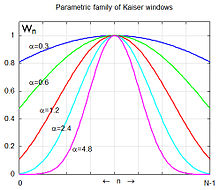凯泽窗
凯泽窗(Kaiser window)是由贝尔实验室的James Kaiser所提出的。凯泽窗是一个单参数的窗函数群,用在数码信号处理中,其定义如下[1][2]:

其中:
- N 为序列的长度
- I0 是零阶的第一类修正贝索函数
- α 是任意非负实数,用来调整凯泽窗的外形。在频域上可以在主瓣(main-lobe)宽度及旁瓣(side lobe)大小中取拾,这是窗函数设计的重要考量因素。
若N为奇数,窗函数最大值会在 。若N为偶数,窗函数最大值会在 。
傅立叶变换
编辑若将上述离散数列视为是连续函数,并进行傅立叶变换:
w0(t)的最大值为w0(0) = 1. 上述的w[n]数列为以下函收的取様:
- ,在间隔T的时间进行取样。
而且rect()为矩形函数. W0(f)主瓣后的第一个零点在:
调整α可以在主瓣的宽度及旁瓣大小中进行取舍。若α增加,W0(f)主瓣的宽度增加,而旁瓣的大小减小,如右图所示。α = 0会对应长方形的窗函数。若α增加,时域及频率下凯泽窗的形状都会接近高斯曲线。凯泽窗在频率0附近的集中程度是几乎最佳化的(Oppenheim et al., 1999)。
脚注
编辑- ^ Harris, Fredric j. On the use of Windows for Harmonic Analysis with the Discrete Fourier Transform (PDF). Proceedings of the IEEE. Jan 1978, 66 (1): 73–74 [2017-01-29]. doi:10.1109/PROC.1978.10837. (原始内容存档 (PDF)于2017-03-19). Article on FFT windows which introduced many of the key metrics used to compare windows.
- ^ Kaiser, James F.; Ronald W. Schafer. On the Use of the I0-Sinh Window for Spectrum Analysis. IEEE Transactions on Acoustics, Speech and Signal Processing. February 1980,. ASSP-28 (1): 105–107.
- ^ Kaiser, James F.; Schafer, Ronald W. On the use of the I0-sinh window for spectrum analysis. IEEE Transactions on Acoustics, Speech, and Signal Processing. 1980, 28: 105–107. doi:10.1109/TASSP.1980.1163349.
参考资料
编辑- Oppenheim, A. V.; Schafer, R. W.; Buck J. R. Discrete-time signal processing. Upper Saddle River, N.J.: Prentice Hall. 1999. ISBN 0-13-754920-2.
- Kaiser, J. F. (1966). Digital Filters. In Kuo, F. F. and Kaiser, J. F. (Eds.), System Analysis by Digital Computer, chap. 7. New York, Wiley.
- Craig Sapp, Kaiser-Bessel Derived Window Examples and C-language Implementation, Music 422 / EE 367C: Perceptual Audio Coding (Stanford University course page, 2001).
![{\displaystyle w[n]=\left\{{\begin{matrix}{\frac {I_{0}\left(\pi \alpha {\sqrt {1-\left({\frac {2n}{N-1}}-1\right)^{2}}}\right)}{I_{0}(\pi \alpha )}},&0\leq n\leq N-1\\\\0&{\mbox{otherwise}},\\\end{matrix}}\right.}](https://wikimedia.org/api/rest_v1/media/math/render/svg/a81b40939275883d17aec37311fa6417bac74d7f)
![{\displaystyle \scriptstyle w[(N-1)/2]=1,}](https://wikimedia.org/api/rest_v1/media/math/render/svg/cd9d2b63c9d36d6abe8019c816e3d8c05ef31284)
![{\displaystyle \scriptstyle w[N/2-1]\ =\ w[N/2]\ <\ 1.}](https://wikimedia.org/api/rest_v1/media/math/render/svg/7835fbb025165c645caa9504efdd368392964bcd)